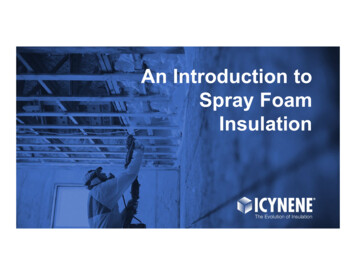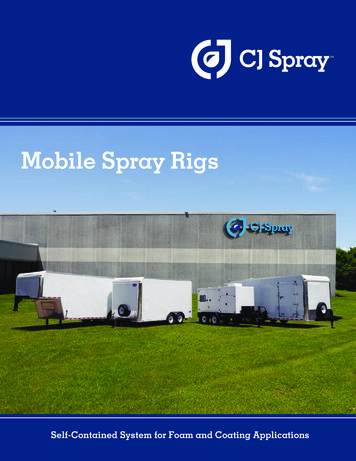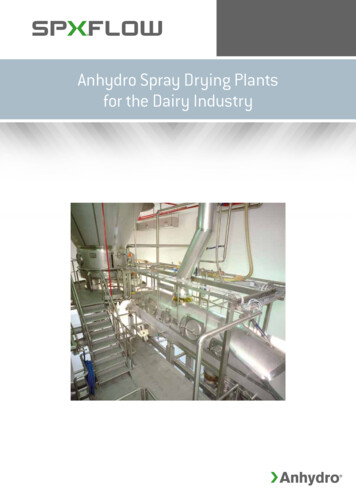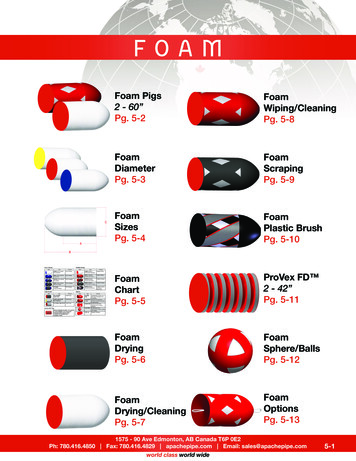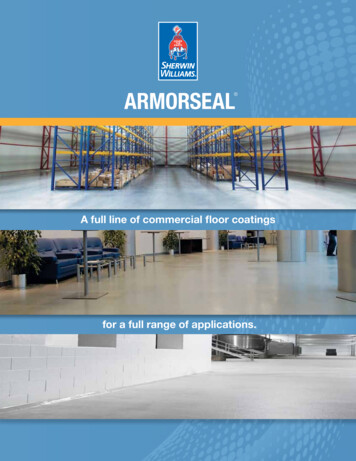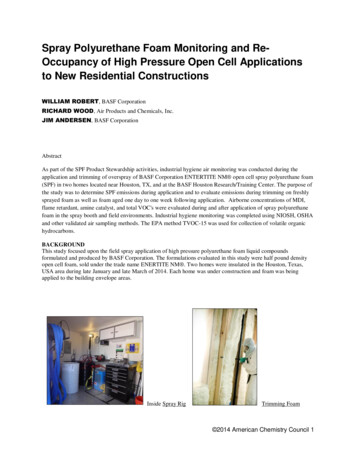
Transcription
Spray Polyurethane Foam Monitoring and ReOccupancy of High Pressure Open Cell Applicationsto New Residential ConstructionsWILLIAM ROBERT, BASF CorporationRICHARD WOOD, Air Products and Chemicals, Inc.JIM ANDERSEN, BASF CorporationAbstractAs part of the SPF Product Stewardship activities, industrial hygiene air monitoring was conducted during theapplication and trimming of overspray of BASF Corporation ENTERTITE NM open cell spray polyurethane foam(SPF) in two homes located near Houston, TX, and at the BASF Houston Research/Training Center. The purpose ofthe study was to determine SPF emissions during application and to evaluate emissions during trimming on freshlysprayed foam as well as foam aged one day to one week following application. Airborne concentrations of MDI,flame retardant, amine catalyst, and total VOC's were evaluated during and after application of spray polyurethanefoam in the spray booth and field environments. Industrial hygiene monitoring was completed using NIOSH, OSHAand other validated air sampling methods. The EPA method TVOC-15 was used for collection of volatile organichydrocarbons.BACKGROUNDThis study focused upon the field spray application of high pressure polyurethane foam liquid compoundsformulated and produced by BASF Corporation. The formulations evaluated in this study were half pound densityopen cell foam, sold under the trade name ENERTITE NM . Two homes were insulated in the Houston, Texas,USA area during late January and late March of 2014. Each home was under construction and foam was beingapplied to the building envelope areas.Inside Spray RigTrimming Foam 2014 American Chemistry Council 1
House Number 1The first home (above) located in near Houston in Fulshear, Texas was being sprayed on the second floor wall areasand parts of the underside of the plywood roof deck while we tested in late January 2014. The applicator hadseveral parts of this home project already insulated with ENERTITE NM from previous trips to the jobsite. Part ofthe sampling for the open cell high pressure SPF components was also conducted at BASF’s facility while a workerscarf or trimmed and cut the foam.SideFrontHouse Number 2The second home was a very large home ( Approx. 7,000 square feet) consisting of 2 floors and a loft area. Wemonitored during application of foam to each floor and during trimming to evaluate the worker’s potential exposureto the SPF components. At times the tasks such as trimming were all that was going on, no spraying. Other times,multiple tasks were going on such as trimming in one area, spraying and trimming in another area of the house. Attimes two rigs were spraying at the same time and also trimming going on. Sampling was conducted in late March 2014 American Chemistry Council 2
in the Houston (Woodlands area), Texas. There was no attempt to mechanically ventilate emissions with engineeringcontrols; however open doors and windows provided natural ventilation in the house during the days we monitored.The typical finished open cell half pound density SPF foam is field manufactured when the liquid “A” side and theliquid “B” side are combined though special high pressure heated airless spray application equipment. The “A” sideor specific chemical called polymeric methylene diphenyl diisocyanate (PMDI), contains approximately equalamounts of monomeric MDI (4,4’MDI, a two ring structure) and higher molecular weight oligomers of MDI (three,four and five ring structures). The “B” side is a blend of predominantly polyol, with flame retardants, catalysts, andsurfactants.The applications were performed by D7 Spray Foam Insulation employees and followed CPI’s and OSHA’sguidance on personal protective equipment and the CPI/ Spray Foam Coalition SPF Industry best practices. Thisincluded nitrile gloves, a full face air supplied respirator, full Tyvek suit to minimize exposed skin. Individuals notspraying or helping were not allowed in the spray area. PPE was used by those monitoring near the spray area or inor near the house. The collection and work stations were located well away from the active spray or trimming areas.The top of thestairwell showsboth a TO-15sample collectioncan as well asimpingers whichwere used tocollect airsamplesChemicalPolymeric methylene diphenyldiisocyanateMonomeric methylene diphenyldiisocyanateTable 1: SPF Chemicals Selected for EvaluationLiquid A – Side CompoundCommon NameOccupational Exposure LimitPMDINot Established2, 4 - MDI and 4,4 - MDI0.005 ppm*Liquid B – Side CompoundTertiary Amine ethylaminoethylethanolamineFire RetardantTris-(1-chloro-2-propyl) phosphateTotal Volatile Organic ChemicalsBDMAEE0.05 ppm*TMAEEANot EstablishedTCPPTVOVNot EstablishedNot EstablishedThe Occupational Safety & Health Administration (OSHA) specifies a ceiling limit for MDI of 20 parts per billion(ppb), equivalent to 0.2 mg/m3. This is the exposure concentration which should never be exceeded withoutrespiratory protection.*The American Conference of Industrial Hygienists (ACGIH) Threshold Limit Value (TLV) guideline for MDI is 5ppb as an 8-hour Time-Weighted Average (TWA). 2014 American Chemistry Council 3
The current occupational exposure limit for MDI applies only to the 2-ring monomeric MDI (Diphenylmethane4,4’-diisocyanate CAS # 101-68-8). The MDI that is used in the SPF industry is a polymeric version of MDI, whichcontains monomeric MDI as well as other higher ring isomers of MDI. The combination of the 2-ring and 3-ringMDI isomers typically constitutes approximately 80% of the total MDI isomers contained in polymeric MDI. Somemanufacturing processes can generate aerosols that result in a greater potential for exposure to the 3-ring isomer.Therefore, for the purposes of providing a more accurate assessment of MDI exposure and body burden to the activemetabolic isocyanate functional group, we report the 2-ring, 3-ring, and total MDI. For regulatory compliancepurpose, the occupational exposure limit is applied to only the 2-ring MDI. However, BASF recommends andencourages customers to evaluate and develop a MDI control program based on the combination of the 2-ring and 3ring isomer.There is no Occupational Safety & Health Administration (OSHA) permissible exposure limit (PEL) nor AmericanConference of Industrial Hygienists (ACGIH) Threshold Limit Value (TLV) guideline for the flame retardant,Trichloropropyl phosphate (TCPP).The amine catalysts were bis(2-Dimethylaminoethyl)ether (BDMAEE) and N,N,NTrimethylaminoethylethanolamine (TMAEEA). There are no established OSHA PEL’s for the amine catalystsmonitored during this survey; however, the American Conference of Industrial Hygienists (ACGIH) has set a TLVof 0.05 ppm as an 8-hour TWA and a Short Term Exposure Limit STEL of 0.150 for BDMAEE. There have beenno inhalation studies that conclusively establish concentrations which workers can be repeatedly exposed day afterday without adverse effect for N,N,N- Trimethylaminoethylethanolamine (TMAEEA).In addition to common raw materials, the levels for certain VOCs were also monitored. No standards have been setfor VOCs in non-industrial settings.ANALYTICAL TECHNIQUES AND METHODSMDIAir sampling pumps were used to collect area samples of MDI aerosol and vapor. The pumps were calibrated to aflow rate of 1.0 L/minute with a flow calibrator before and after sampling. The average flowrate was used tocalculate air volumes unless otherwise noted. The MDI samples were collected in 15 mls of 1-(2-pyridyl) piperazine(1,2-PP) in glass impingers with a backup 13 mm glass fiber filter, impregnated with 5 mg of 1-(2-pyridyl)piperazine (1,2-PP). Impingers were changed to keep sample times less than four hours. After samples werecollected, the filter was removed from the cassette with tweezers and placed in a vial. Two milliliters of 90%acetonitrile and 10% dimethyl sulfoxide solution (DMSO) with 1,2-PP were rinsed through the front tapered sectionof the filter cassette to flush dust on the inside of the cassette into the vial containing the filter. The vial was handagitated to ensure the particulate on the filter was completely wetted by the acetonitrile/DMSO solution.The vials of acetonitrile/DMSO solution with filters, along with a blank filter in a vial of solution, were shipped tothe BASF lab in Wyandotte, Michigan. The samples were analyzed following a modified version of NIOSH 5521Method at an American Industrial Hygiene Association (AIHA) accredited laboratory. The deritivization solventused was 1,2 PP instead of 1, 2 MP 1-(2-methoxyphenyl) piperazine as noted in NIOSH Method 5521 because thelab is much more familiar with this solvent. To ensure there was no breakthrough of MDI, a backup filter was usedas described in NIOSH Method 5525. The concentration of MDI reported in parts per billion, includes MDI vaporand MDI associated with foam particles.To assess the potential health impact of polymeric MDI, the concentration of two plus three ring MDI was alsocalculated for comparison to the occupational exposure limit.Triethyl Phosphate (TCPP)Air sampling pumps were used to collect area samples of TCPP vapor. The pumps were calibrated to a flowrate ofaround 1.0 L/minute with a flow calibrator before and after sampling. The average flowrate was used to calculate airvolumes unless otherwise noted. Samples were collected on a XAD-7 OVS tube (glass fiber filter, 13-mm; XAD-7,200mg/100mg) per NIOSH Method 5523. The XAD-7 OVS tubes, along with a blank tube, were shipped to theBASF lab in Wyandotte, Michigan. The samples were analyzed following NIOSH 5523 Method at an AmericanIndustrial Hygiene Association (AIHA) accredited laboratory. The concentration of TCPP was reported as ppm (and)mg/m3. 2014 American Chemistry Council 4
Amine Catalyst Monitoring MethodsTwo amine air sampling methods were used for portions of the study. Samples collected during the application andtrimming tasks conducted during residential SPF application were obtained using standard field monitoringprocedures. A second method having greater analytical sensitivity was used in the spray booth to evaluate catalystemissions during the trimming of aged SPF.Air samples collected during SPF application in the two homes for amine catalyst evaluation were collected bydrawing air through tubes containing XAD-2 sorbent material with calibrated Gillian low flow pumps. Followingcollection, the samples were submitted to the ESIS Environmental Health Laboratory, an AIHA accreditedlaboratory, where they were solvent desorbed and analyzed by gas chromatography using an NPD detector.Air samples collected in the BASF Houston Research and Training Center during the trimming of aged SPF wereobtained in accordance with the procedure described in the draft ASTM work item 40292 “Sampling andDetermination of Vapor-Phase Organic Compounds Emitted from Spray Polyurethane Foam (SPF) Insulation inMicro-Scale Chambers using Sorbent Tubes Analyzed by Thermal Desorption Gas Chromatography and MassSpectrometry”. Pumps equipped with low flow adapters were used to draw air through glass tubes containing Tenaxsorbent material. Following sample collection, both amine catalyst and TCPP were thermally desorbed from theTenax and analyzed by the GC/MS method described in the draft ASTM standard.Total Volatile Organic Hydrocarbon (TVOC) EPA Method TO-15The atmosphere sample is drawn into a specially-prepared stainless steel canister. The canister is an evacuatedcanister that is cleaned of all residual chemicals and sealed. A field sample of air is drawn through an orificeconnected to the can with a gauge to regulate the rate and duration of sampling into the pre-evacuated canister.Canisters were sealed and shipped back to a third party laboratory for analysis per EPA TO-15 method for the firstand second homes.It should be noted in the laboratory report, parts per billion concentrations of acetone, hexane, ethanol and toluenewere detected which are not reported in this paper. These solvents were all expected due to construction of thehomes and usage of adhesive and glues containing these products. Toluene was introduced to each home by thetoluene impinger method used to capture MDI. Thus, these chemicals were not reported herein.SAMPLE LOCATIONSThe sampling plan was designed to collect and measure major chemical ingredients contained in the liquid A and Bcompounds and to determine if any SPF chemical components become airborne during and after application. SPFchemicals monitored include: MDI (2-ring and 3-ring) the A side component; TCPP, a flame retardant, total volatileorganic hydrocarbons (TVOC – a scan of solvents and odoriferous compounds that may be present in indoor air perEPA method TO-15) and amine catalysts.Air sampling for amine catalyst and TVOC-15 were collected on the second floor and the main level in both homeswhere other trade workers could potentially be exposed during SPF application. The study evaluated area samplesfor MDI, TCPP and TVOC during SPF application. Personal samples were also gathered for amines during SPFapplication. As noted earlier, previous data on MDI exposures indicate the sprayer and his helper generally exceedrecommended exposure guidelines, therefore personal air monitoring for MDI was not conducted. The applicatorand helper wore supplied air respirators and full personal protective equipment during all spray application activities.The personal protection equipment provided worker protection for eyes, respiratory and skin overspray exposure.Laboratory EvaluationsIn an effort to evaluate emissions under controlled conditions, air monitoring was completed at BASF’s Researchand Technical Training Center in Houston. Panels, approximately 3ft x 4ft were sprayed with Enertite (BASF TradeName) open cell formulation and placed in a ventilated spray booth. The mechanical ventilation was not inoperation throughout the experiments. Air monitoring was then conducted during a 30 min period as the panelswere cut and scraped to simulate a worst case scenario. Both aged foam sprayed 5 days previously and foam 2014 American Chemistry Council 5
sprayed 4 hours prior to sampling were tested on two separate days. Area samples were gathered for MDI, andTVOC. Personal samples were obtained for TCPP and BDMAEE. Wipe samples were also gathered for free NCOon the surface of the foam. With the exception of the amine catalyst, all were within acceptable limits.Personal samples results for BDMAEE ranged from 0.07 to 0.36 ppm. The results do not represent full shiftexposures; however they do indicate the potential for excessive exposure to unprotected workers during trimmingoperations for both fresh foam and foam sprayed five days prior to trimming.Note: PPE in the shown pictures.The samples were sprayed in thespray booth and this is also wherethe trimming was done andmeasurements shown as indicatedby the red arrow pointing to the TO15 air sample collection canSample collection equipment isindicated by RED arrows in thephotograph.Wall stud cavity mock ups wereused, so continuous measurementscould be taken while several panelswere trimmed during several hours 2014 American Chemistry Council 6
Field EvaluationsIn late March, sampling was initiated again in the Houston (Woodlands), Texas during application of open cell foam.The home was being insulated using open cell foam as a building envelope insulation and air barrier application.Ceiling heights of (12-15 feet) and most rooms were sized (20 x 30 feet) were much higher and larger thantraditional homes. This was a very large 7,000 square foot high end home. The walls had not been installed yet.So the sprayer and his helper used air purifying respirators. Area (for MDI and TCPP) samples (north and southends) were obtained during spraying of SPF about 10 to 15 feet from the applicator on the second floor. Areasamples (for MDI, amines, and TCPP) were obtained while trimming foam immediately after spraying. The next day,samples (for MDI and TCPP) were taken during trimming foam sprayed the previous day.On the first floor, the second day the applicator applied foam on the walls (samples for MDI and TCPP wereobtained about 10 – 15 feet from the sprayer).Personal amine samples were collected the first day as sprayers and helpers sprayed attic areas in the northeast andsoutheast wings of the house. Air samples were also collected as helpers trimmed excess foam minutes afterapplication. On the second day additional personal samples were collected as SPF was applied to the first floor. Apersonal sample was also collected as a helper trimmed foam on the second floor. The foam had been sprayed theprevious day.RESULTS AND DISCUSSIONSFirst Home (attic and walls)The first house in Fulshear, TexasMDI was detected (1st floor stair well 0.072 ppb and 2nd floor top of stairwell 0.12 ppb) in area samples duringspray polyurethane foam application on the second floor. TCPP, the flame retardant, level was not measured due tothe loss of the samples in transit to the lab. TVOC samples were in the parts per trillion. Common solvent such asacetone, ethanol and isopropanol were noted with the high sample of 19 ppt. An area sample for MDI was also takenin the spray rig on top of the MDI drum; results were below detection. An area sample for MDI was taken duringcutting and trimming of foam in the BASF facility. It was also below detection limits.Personal samples collected on the sprayer and his helper during spraying and trimming on the second floor forBDMAEE catalyst ranged from 0.33 to 0.51 ppm. One area sample collected on the first floor resulted in aconcentration of 0.021ppm. TMAEEA was non-detectable. As noted, applicators were in full personal protectiveequipment.Second Home, first day (Attic, 1-3 walls and ceiling)The second house in Woodland, Texas,It was sprayed in late March of 2014, and was a very large home. Area samples were obtained during SPFapplication on the north and sound end of the home. There were two teams (a sprayer and his helper) applying foam.Area samples were taken for MDI and TCPP 10-15 feet from the sprayer. On the north end, MDI and TCPP werebelow detection limits. The south sprayer seemed to be much closer to the area sampler because MDI was measuredat 1 ppb for the monomer and below detection for the 3 ring MDI. TCPP was 16 ppb (0.15 mg/m3). Area sampleswere obtained during trimming of the foam. One operator was next to the applicator during spraying trimming 2014 American Chemistry Council 7
within minutes after application. His exposure was 2 ppb for 2 ring MDI monomer and 0.55 ppb for 3 ring MDI andTCPP results were 12 ppb (0.11 mg/m3). The other helper, who trimmed 15 plus feet from the sprayer, did not havea detectable concentration of MDI and TCPP was 8 ppb (0.09 mg/m3). TVOC samples were in the parts per trillion.Common solvent such as acetone, ethanol and isopropanol were noted with the high sample of 26 ppt.BDMAEE catalyst samples during application in the attic areas ranged from 0.52 to 4.52 ppm. Two personalsamples collected during the trimming of fresh SPF were 1.24 and 1.34 ppm. TMAEEA was detected in only twosamples as SPF was sprayed in the confined attic area. All other concentrations were below detection limits.Second Home; second day (trimming on 2nd floor; SPF on 1st floor)MDI was non-detectable (one hour sample) during trimming of the foam. TCPP was extremely low also at 1.4 ppb(0.016 mg/m3). Air samples were taken about 10-15 feet from the SPF applicator on the first floor. MDI was 0.22ppb for 2 ring MDI and ND for the 3 ring; TCPP was measured at 3.7 ppb (0.026 mg/m3). The TVOC’s sampleswere in the parts per trillion. Common solvent such as acetone, ethanol and hexane were noted with the high sampleof 29 ppt. BDMAEE catalyst concentrations for personal samples collected during spray application on the firstfloor were 0.76 ppm and 1.84 ppm. A personal sample collected during the trimming of foam sprayed 24 hoursearlier resulted in a BDMAEE concentration of 0.073. An area sample collected in the central area of the secondfloor during the trim operation also resulted in a concentration of 0.073 ppm. TMAEEA concentrations were allbelow analytical detection limits.RECOMMENDATIONS AND CONCLUSIONSMDI concentrations were measurable if the trimmer moved within about 15 feet of the sprayer. TCPP results werealso measured at this distance from the sprayer. Trimming of foam showed if the worker was not close to the SPFapplicator, there was no detectable concentration of MDI. Concentrations of the emissive catalyst, BDMAEEexceeded the ACGIH TLV-TWA of 0.05 ppm during application and during the trimming of fresh foam and foamaged for 24 hours. The non-emissive catalyst, TMAEEA was only detected in two personal samples collectedduring the application in the confined attic space having no mechanical ventilation.Based on the findings from this study, the authors believe that current PPE and work practice recommendations forspray foam applicators must be followed. It is also recommended that mechanical ventilation be used during andafter application as recommended by the Environmental Protection Agency and the Center for the PolyurethanesIndustry, to reduce emissions, particularly emissive catalyst concentrations below occupational exposure limits. Theauthors also recommend additional research is needed to provide data related to long term emissions from open cellformulations.Any technical advice furnished or recommendation made by the authors concerning any use or application of anyproduct is believed to be reliable but the authors make no warranty, either express or implied, as to its accuracy orcompleteness or of the results to be obtained. With regard to any handling of any product it should be done safelyand follow guidelines presented at www.spraypolyurethane.org.REFERENCES1. “Ventilation and Re-Occupancy of a Residential Home Sprayed with High Pressure Polyurethane Foam byRobert, Andersen, Wood and Bogdan, CPI Presentation2 “Spence, M., 2009. “The Current MDI Industrial Hygiene Data on Spray Foam” in Center for thePolyurethanes Industry (CPI) Conference, 2009.3. “Personal Protective Equipment Sheet,” published by the American Chemistry Council’s Center for thePolyurethanes Industry4. Wood, Richard. “CPI Ventilation Project Phase 1 and Phase 2 Update.” Presented at the CPI TechnicalConference, September 2012.5. Wood, Richard. “CPI Ventilation Project Update.” Presented at the CPI Technical Conference. September2013. 2014 American Chemistry Council 8
6. “Ventilation Guidance for Spray Polyurethane Foam Application,” published by the U.S. EnvironmentalProtection Agency (EPA) 2010.7. “Ventilation Considerations for Spray Polyurethane Foam,” published by the American Chemistry Council’sCenter for the Polyurethanes Industry. 20138. website is study was conducted and supported by Bill Robert, Jim Andersen of BASF Corporation; Richard Wood of AirProductsThe project was completed with the support of various BASF Corporation employees including:Todd Wishneski, Marcus Hunter, Spencer Davis and Anthony ColemanIndustrial Hygiene & Environmental Analytics LabElizabeth HugelBIOGRAPHIESWilliam Robert, (CIH)Bill received his Masters in Occupational and Environmental Health from Wayne State University in 1981 andbecame a Certified Industrial Hygienist in 1990. He currently works for BASF Corporation Polyurethanes Group asthe Manager of Product Stewardship. He has been active in Product Stewardship Outreach to downstream usersthrough various Polyurethane Trade Groups such as the International Isocyanate Institute, the American ChemistryCouncil’s Diisocyanates Panel, Spray Polyurethane Foam Association and the Center for the Polyurethane Industry.James AndersenJames Andersen is Marketing Applications Specialist SR for BASF Corporation US Spray Foam Systems Groupand has worked for BASF since 2004. He has been active in CPI, SPFA, NRCA and other trade associationsworking with safety, applications, products, equipment, technical and training. He has been in the spray foamindustry for 40 years as a contractor, distributor and systems compounder and has worked in several capacities overhis career. He attended Wisconsin State University-Whitewater where he received a Bachelor’s degree in BusinessAdministration and Economics.Richard Wood, (CIH)Richard Wood is a Certified Industrial Hygienist (CIH). He earned a BA in Biology and Chemistry from EasternMichigan University and a Master of Public Health degree specializing in Industrial and Environmental Health fromthe University of Michigan. Rick has worked for Air Product and Chemicals, Inc. for over 30 years as the Manager,Global Industrial Hygiene Services. He is responsible for managing industrial hygiene teams and activities for AirProducts global operations as well as providing product stewardship support to the epoxy and polyurethane additivesbusiness areas.This paper may contain copyrighted material, the use of which has not always been specifically authorized by thecopyright owner. In accordance with Title 17 U.S.C. Section 107, the material in this paper is being used fornonprofit educational purposes and will not be made available for distribution. ACC believes this constitutes a ‘fairuse’ of any such copyrighted material as provided for in section 107 of the US Copyright Law. For moreinformation, go to: http://www.copyright.gov/title17/92chap1.html#107. If copyrighted material from this paper isfurther used for purposes that go beyond “fair use,” permission from the copyright owner must be obtained. 2014 American Chemistry Council 9
foam in the spray booth and field environments. Industrial hygiene monitoring was completed using NIOSH, OSHA and other validated air sampling methods. The EPA method TVOC-15 was used for collection of volatile organic hydrocarbons. BACKGROUND . This study focused upon the field spray application of high pressure polyurethane foam liquid compounds
